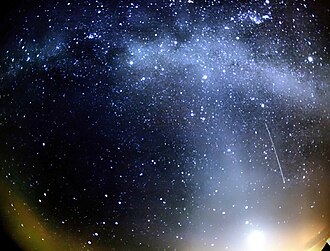Orionids
| Orionids | |
|---|---|
| Activity period | October 2nd - November 7th |
| Activity maximum | October 21 |
| Radiant position of the maximum |
RA : 6 h 20 m DE : + 16 ° |
| ZHR | 20 to 30 |
| Population index | 2.5 |
| geocentric speed | 66 km / s |

The Orionids are one of the five most active meteor streams . Every year in October they become noticeable as a swarm of shooting stars , most of all in the morning hours of the days from October 19th to October 23rd . A noticeable number can be observed between October 12th and 29th.
The millimeter-sized particles are only a few milligrams in weight, but due to their high speed they still generate a bright tracer by ionizing the air particles in the high atmosphere . In contrast to sporadic (randomly distributed) meteors , they have almost parallel orbits in space because of the common comet of origin.
As a result, they seem to come out of their vanishing point in the sky , the so-called radiant , which is in the northeast of Orion , about 10 ° to the left above the red giant star Betelgeuse . Outside the cities, you can freiäugig see this trail you with an hour about 10 radar methods has examined more closely.
From serial photographs , you can combine those images on which meteors are depicted. Then the radian can be determined exactly, and with a suitable choice of the exposure time also the hydrogen clouds glowing in faint red, which represent several star formation areas around Orion.
The Orionids are loose clouds of scattered material from Halley's Comet , which over the millennia have been distributed along the entire comet's orbit due to the influence of small orbital disturbances and the solar wind . The Eta-Aquariids of the first half of May also come from Halley's Comet, but from a different point on its slender elliptical orbit.
Individual evidence
- ↑ IMO Meteor Shower Calendar 2020 , accessed April 16, 2020
- ↑ Cuno Hoffmeister , data table in "Which star is that", p.151, Kosmos-Verlag 1958.
- ↑ Space picture of the day (12.12.2018): Orionids and star formation regions
literature
- Cuno Hoffmeister: Meteor Streams . Joh. Ambr. Barth Verlag, Leipzig (1948)
- Fritz Heide: A little meteorite science . Understandable Science Volume 23, Springer-Verlag, Berlin 1957

